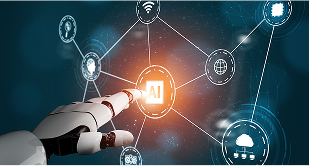Hyper Connected Reality Systems
& Securing the Cyberspace
Amrita will be at the forefront of research in hyper-connected reality
systems, encompassing advancements in virtual reality, augmented reality,
and the Internet of Things (IoT). We will also address cybersecurity
challenges associated with these evolving technologies.


This area focuses on Digital India and the Smart Cities Mission by the Ministry of Housing and Urban Affairs. Hyper-Connected Reality Systems (HCRS) can bridge the digital divide, optimize resource allocation, and empower Make in India through automation. Robust cybersecurity research is crucial, including data privacy, AI security, and secure communication protocols for IoT devices. By prioritizing HCRS development and cybersecurity research, our research aims to make India a leader in this domain and ensure a secure digital future.
Text BoxThe research area contributes to Sustainable Cities and Communities (SDG 11) by creating smart cities with efficient traffic management, waste reduction, and optimal resource allocation. Integrating IoT sensors, AI analytics, and AR/VR interfaces enhances sustainability and residents’ quality of life.

Integrating hardware and embedded systems with IoT/IIoT technologies,
focusing on efficient hardware design, encryption, and authentication methods.

Establishing secure connectivity by integrating security measures with image processing, AI algorithms, and hardware and embedded security solutions.

Advance human-centric computing through the integration of Lifelong Machine Learning (LLM), graph theory, and heterogeneous data integration techniques.

Text BoxText BoxAddresses ethical financial reporting by employing encryption and edge intelligence technologies, integrating IoT and digital twin concepts, and utilizing AI-based financial modeling approaches.

Advance autonomous vehicles through the enhancement of robotics and communication technologies, optimization of hardware efficiency, and the prioritization of safety and quality measures.

Anomaly detection by employing lightweight algorithms, integrating multisensor data fusion techniques, leveraging Industrial Internet of Things (IIoT), and implementing digital twin technologies

Enhance security through the integration of authentication methods with biometrics and AI, within the framework of the Internet of Battlefield Things (IoBT).
Ubiquitous Artificial
Intelligence
To unlock transformative potential across all domains and address global challenges, Amrita explores Ubiquitous AI, empowering the future by integrating seamless information flow, AI-enhanced human intelligence, and immersive experiences to bridge the physical and digital realms.


This focus area aligns with India’s national missions such as ‘Digital India’, ‘Sugamya Bharat Abhiyan’ (Accessible India Campaign), ‘Skill India mission’, ‘Sarva Shiksha Abhiyan’, and ‘Rashtriya Madhyamik Shiksha Abhiyan’ by promoting digital literacy, accessibility, inclusive education, and technological skills development among learners.w
Text BoxThe research pathways in this area aligns with multiple United Nations Sustainable Development Goals (SDGs) including Quality Education (SDG 4), Reduced Inequalities (SDG 10), Industry, Innovation, and Infrastructure (SDG 9), and Good Health and Well-being (SDG 3) by promoting inclusive education solutions, digital literacy, lifelong learning, holistic well-being, and empathy-friendly pedagogy.

Utilizing disease modeling techniques alongside multimodal data processing on smart cloud platforms, integrated with Brain-Computer Interface (BCI) technology.

Developing predictive behavioral models through genomic analysis, employing machine learning (ML), deep learning (DL), and language learning models (LLM), and fostering human-machine teaming through generative AI and neural link technologies.

Addressing intellectual disabilities in children through image processing and content mining techniques, utilizing machine learning (ML), deep learning (DL), natural language processing (NLP), and natural language modeling (NLM), with a focus on promoting inclusive quality education as per Sustainable Development Goal 4 (SDG4).

The research pathway aims to enhance educational skill assessment through the use of graphical models and community engagement strategies, leveraging reinforcement learning techniques and collaborative intelligence methodologies.

Enhancing health through the utilization of learning algorithms, incorporating human-machine training/learning paradigms, and integrating generative AI with digital twin technology.

Detect corporate fraud by employing natural language processing (NLP), reinforcement learning (RL), or limited memory learning (LLM) algorithms, within the context of financial technologies, while exploring the potential of brain-computer interface technology and text filling grammatics.

Early childhood development through the integration of heterogeneous data analytics, leveraging edge intelligence in conjunction with large multimodal systems.

Support neurodiversity through the implementation of assistive technology, utilizing super large multimedia AI systems, and enhancing community engagement with the assistance of generative AI technologies.

Safeguard vulnerable communities through bio-inspired analysis and design, leveraging Internet of Things (IoT) and Geographic Information Systems (GIS) technologies, as well as integrating 6G connectivity and large-scale AI models.